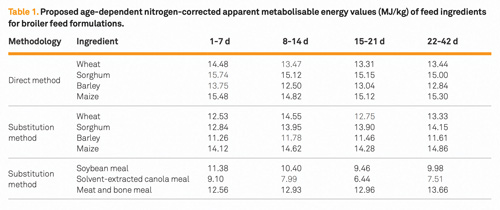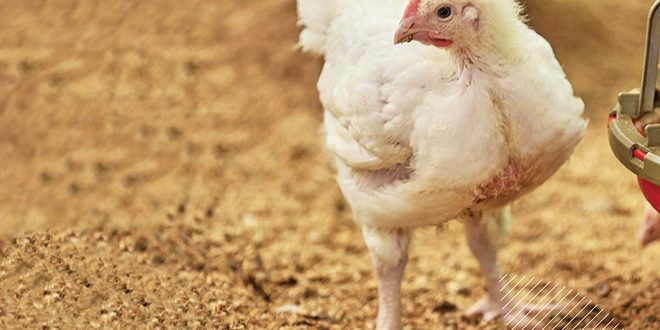ABOVE: The age of broilers has a significant effect on how well they digest and absorb energy-yielding nutrients and amino acids. meat
The age of broilers has a significant effect on how well they digest and absorb energy-yielding nutrients and amino acids.
The capacity of the digestive tract to digest and absorb nutrients is limited during the early life of broilers and there is consensus that nutrient digestibility generally increases with age.
However, most published data on the apparent metabolisable energy and digestibility of AA in feed ingredients have been generated with either adult cockerels or older broilers – typically five weeks old – and are widely used in feed formulations for all phases of broiler growth.
The relevance of using a single value of AME and digestible AA obtained with older birds for all growth phases of broilers, especially their early life, is questionable and highlights the need for age-dependent estimates for use in feed formulations.
This project included eight feeding studies to determine the endogenous energy and AA losses at different ages of broilers, investigating age-related AME and AA digestibility of four cereals and three protein sources commonly used in the Australian chicken meat industry.
This research, for the first time, provides information on the AME and digestible AA content in common feed ingredients from hatch to the end of the broiler growth cycle.
The findings suggest bird age influences AME and AA digestibility of feed ingredients, and the effect varies and depends on the feed ingredient, assay methodology and specific AA.
It is concluded the precision of feed formulations can be improved by using age-specific AME and digestible AA values.
Background
Not all nutrients in ingredients are available to broilers, and a portion of nutrients are excreted undigested or not utilised.
In the case of AA, a recent development has been the wider use of digestible AA, rather than total AA, concentrations in feed formulations.
This approach improves the precision of the formulations, may lower feed cost and ensures more predictable bird performance.
The use of the appropriate energy system is another critical issue because of the importance of energy-to-bird performance and diet cost.
Despite its limitations, AME is the system of choice to describe the available energy of different feed ingredients.
However, the application of a single value based on older birds for AME and digestible AA to all growth phases of broilers is questionable.
Digestibility of various nutrients and metabolisable energy during the first week of life has been reported to be lower compared with older birds.
Moreover, with increased public interest in the environmental impacts of farming, reducing nutrients in effluent from intensive poultry operations is now a major issue.
From the nutrition point of view, the most obvious strategy is to feed broilers to match their requirements, which in turn will reduce the nutrient load in manure.
To do so, the AME and digestible AA content of common feed ingredients at different ages needs to be known and used when formulating broiler diets for different phases.
Hence, the present project investigated the influence of age on the AME and AA digestibility of four cereals – wheat, sorghum, maize and barley – and three protein sources – soybean meal, canola meal and meat and bone meal – commonly used in the Australian chicken meat industry, from hatch to the end of the broiler growth cycle – day 42.
Objectives
The objectives of this project were to:
- Determine AME and standardised ileal digestibility (SID) values of AA in four cereals (wheat, sorghum, maize and barley) and three protein sources (soybean meal, solvent-extracted canola meal, and meat and bone meal) commonly used in Australia at different stages of the broiler growth cycle.
- Refine AME and SID values of AA for bird age to enable accurate formulation of broiler diets for different growth phases.
Methodology
Effects of broiler age on AME and AA digestibility were examined in eight feeding studies using Ross 308 male broilers at weekly intervals from one to 42 days post hatch.
AME of ingredients was determined by the classical total excreta collection, using the direct and substitution (difference) methods.
In both methods, the test diets were fed for seven days, and the feed intake and total excreta output were monitored during the last four days.
AME values of the ingredients were calculated using the method by Hill and Anderson.
SID values of AA were determined using the direct method.
The basal assay diets contained different inclusions of each ingredient – as the only source of AA in the diet.
Titanium dioxide was added to all diets as an indigestible marker.
At the end of each week – days 7, 14, 21, 28, 35 and 42 – all birds were euthanised by an intravenous injection of sodium pentobarbitone and the contents of the lower half of the ileum were collected.
The apparent AA digestibility was calculated using marker ratios in the diets and ileal digesta.
SID of AA was then calculated using age-dependent endogenous AA values obtained from broilers fed a nitrogen-free diet.
Study 1 – Determination of basal ileal endogenous amino acid flows at different ages of broilers.
Study 2 – Age-related SID AA values of wheat and sorghum in broilers.
Study 3 – Age-related SID AA values of barley and maize in broilers.
Study 4 – Age-related SID AA values of soybean meal, canola meal, and meat and bone meal in broilers.
Study 5 – Determination of age-related AME for cereals (wheat, sorghum, maize and barley), direct method.
Study 6 – Determination of age-related AME for cereals (wheat, sorghum, maize and barley), substitution method.
Study 7 – Determination of age-related endogenous energy loss.
Study 8 – Determination of age-related AME for soybean meal, canola meal, and meat and bone meal in broilers, substitution method.
Key findings
This project, for the first time, provided SID AA and AME values for the seven most-used feed ingredients in broiler feeds from hatch to market age.
Key findings stemming from the research are:
- The effect of age on SID AA values varies and depends on the ingredient type and the specific AA, the effect of age on AME values also varies and depends on the ingredient type and the methodology used for energy evaluation
- The difference in the ileal endogenous AA flows at different broiler ages is the prime contributing factor affecting SID AA estimates, especially in grains, therefore the use of age-specific endogenous AA flows data to standardise AA digestibility is recommended
- Ileal endogenous energy loss can be quantified in broilers by feeding them a glucose-based purified diet, broiler age had no effect on the ileal endogenous energy loss estimates
- The age of broilers should be accommodated as a variable within the ingredient matrix in feed formulation packages.
Potential impact
The application of age-appropriate metabolisable energy and SID AA data will enable the poultry industry to improve feed formulation precision, broiler performance, profitability and the sustainability of poultry production.
Tables 1 and 2 present examples of the nitrogen-corrected AME values and standardised ileal digestibility coefficients of lysine, obtained from the current project, that might be incorporated when formulating commercial broiler diets.

Table 1. Proposed age-dependent nitrogen-corrected apparent metabolisable energy values (MJ/kg) of feed ingredients for broiler feed formulations.

Table 2. Standardised ileal digestibility coefficients of lysine in feed ingredients at four broiler feeding phases.
Actions and next steps
Modern feed formulation softwares could easily include and implement the age-dependent values of AME and SID AA for different ingredients.
Formulation of feed ingredients to age-dependent AME and SID AA values could potentially reduce the cost of feed.
However, the benefits of this approach must be tested and confirmed in well-planned feeding trials considering broiler performance, market weight and economic return.
Evaluation of ileal digestible energy, proposed as a potential available energy system in this project, and its suitability for application in broiler feed formulations merits further research investment.
Antinutritive factors, such as soluble non-starch polysaccharides and trypsin inhibitors, substantially affect energy utilisation and AA digestibility in feed ingredients, and the effect is more prominent in younger birds.
An extension of the project would be to determine the influence of carbohydrases and proteases on energy utilisation and AA digestibility at different broiler ages, especially in ingredients with low nutrient digestibility.
Another issue of some interest is the effect of sex on metabolisable energy and AA digestibility in broiler chickens.
Though available data are inconsistent and inconclusive, evidence suggests there are some differences between male and female broilers in their ability to digest and utilise nutrients.
Acknowledgements
We would like to thank the AgriFutures Chicken Meat program for financially supporting this project and for its ongoing invaluable support.
We would also like to thank Evonik (SEA) Pte Ltd and Preethi Ramesh at AMINOLab EMSEA in Singapore for amino acid analyses.
We sincerely appreciate the support received from steering committee members, including Katherine Balding, Georgie Townsend, Peter Chrystal, Rachele Osmond and Sarika Pandya.
Finally, we are immensely thankful for the support and dedicated assistance we received from the Massey University Poultry Research Unit team. meat
Dr M Reza Abdollahi
Associate Professor of Poultry Nutrition
Massey University

